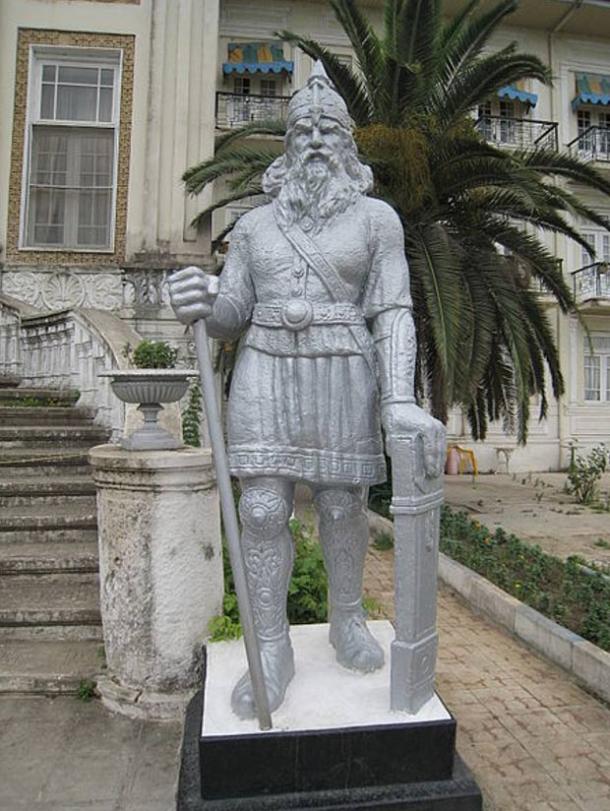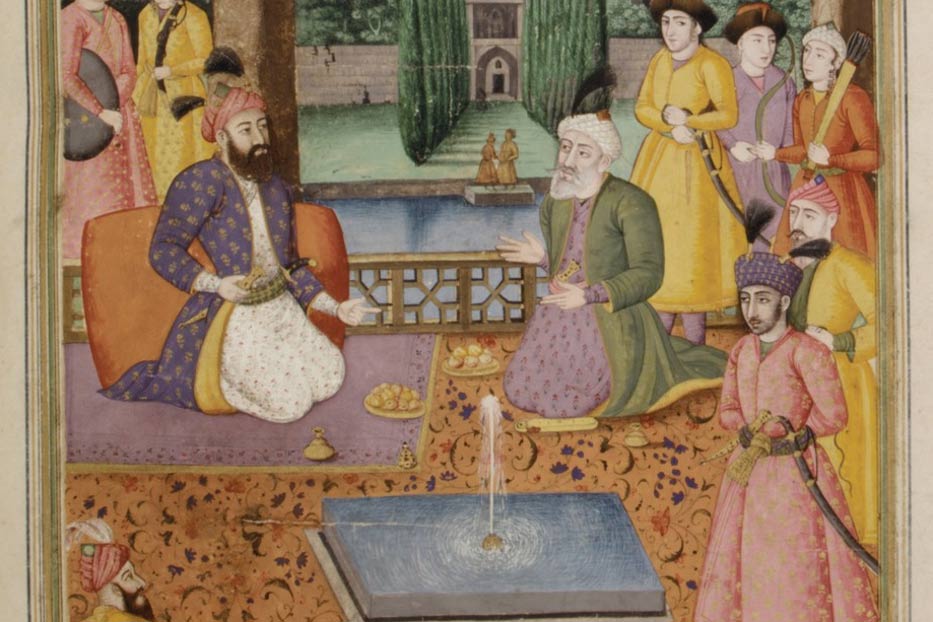The Early Rulers of Persia, Part II: The Kayanian Dynasty
According to Persian epic tradition, the Kayanians were the second dynasty to rule the land which is known today as Iran. The Kayanians succeeded the Pishdadians, whose dynasty ended with the demise of their last king, Garshasp.
This was not just a change in dynasties, but also a change in eras. It was during this period that many of the heroes of Persia were introduced, of which the most renowned is Rostam. These heroes were mighty enough to claim the throne of Persia for themselves, however they did not do so due to their adherence to a code of honor.
A List of Kings
A list of the Kayanian kings can be found in the Zamyâd Yasht of the Avesta, and are identified by their title, ‘kavi’, which is said to mean “(visionary) poet”.
That clave unto Kavi Kavâta, and unto Kavi Aipivôhu, and unto Kavi Usadha, and unto Kavi Arshan, and unto Kavi Pisina, and unto Kavi Byârshan, and unto Kavi Syâvarshan;
So that they were all of them brave, all of them strong, all of them healthful, all of them wise, all of them happy in their wishes, all of them powerful kings.
….
That clave unto Kavi Husravah for the well-shapen Strength, for the Victory made by Ahura, for the crushing Ascendant; for the righteousness of the law, for the innocence of the law, for the unconquerable power of the law; for the extermination of the enemies at one stroke.
Kai Kobad’s Ascension to the Persian Throne
In Ferdowsi’s Shahnameh, a somewhat different set of Kayanian kings are given, again identified by their title, ‘kai’, which is an equivalent of the ‘kavi’ in the Zamyâd Yasht. Like the Avesta, the Shahnameh records that the first king of the Kayanians was Kavi Kavâta, though in the epic, he is referred to as Kai Kobad. The story of Kai Kobad’s ascension to the Persian throne is linked to the exploits of the hero Rostam.
- The Longest Poem Ever Written: Shahnameh – The Epic Book of Kings
- Babak Khorramdin – The Freedom Fighter of Persia
- Has the mystery of the Lost Persian Army finally been solved?

Statue of Rostam in Ramsar, Iran. (CC BY-SA 3.0)
Towards the end of the Pishdadian Dynasty, Persia was facing a crisis. One of the Pishdadian kings, Nowzar, the son of Manuchehr, was slain in battle by Afrasiab, the king of Turan. Afrasiab then sat on the throne of Persia. His reign was short, however, as the Persians, united under the new king, Zaav, succeeded in dethroning him. Zaav was followed by his son, Garshasp.
When Afrasiab learnt of Garshasp’s death, he decided to invade Persia again. With no one to lead them, the Persians turned to Zal, the father of Rostam, to save them. Together with his son, Zal prepared to face Afrasiab’s forces.

Kai Khorso enthroned holding the sword with which he would execute Afrasiyab for the murder of Siyavash. (Public Domain)
Although the army mustered by Zal and Rostam was great in number and consisted of valiant men, they lacked a king to lead them. Addressing his men, Zal spoke thus,
there is wanting to us a chief, for we are without the counsels of a Shah (king), and verily no labor succeedeth when the head is lacking
Nevertheless, there was still hope, as Zal revealed to his men that a Mubid (a Persian wise man) had told him that,
there yet liveth one of the race of Feridoun to whom pertaineth the throne, and that he is a youth wise and brave.
Therefore, Zal dispatched Rostam to Mount Alberz, where the youth, Kai Kobad, was to be found. Rostam found the future king, brought him back to the army, and together they defeated Afrasiab’s army. After returning to Turan, Afrasiab decide to make peace with Kai Kobad, who accepted it.

Kobad lived in the Alborz Mountains and it was Rostam who brought him to the Estaxr capital. (Public Domain)
The Successor of Kai Kobad
Kai Kobad’s reign was followed by a succession of Kayanian kings, each of whom has their own set of interesting stories. To illustrate the fantastic nature of these stories, one example will suffice.
This tale is about the flying throne of Kai Kavoos, Kai Kobad’s successor. In this story, Kai Kavoos’ pride got the better of him, and he attempted to take to the skies, something that was deemed impossible for a human being to do, after being tempted by a deev disguised as a youth. Having pondered for a long time, and consulted numerous wise men, Kai Kavoos finally encountered someone who could help him fly. The following, taken from the Shahnameh, was what he did,
He built him a framework of aloe-wood, and at the four corners thereof he placed javelins upright, and on their points he put the flesh of goats. Then he chose out four eagles strong of wing, and bound them unto the corners of this chariot. And when it was done, Kai Kaous seated himself in the midst thereof with much pomp. And the eagles, when they smelt the flesh, desired after it, and they flapped their wings and raised themselves, and raised the framework with them. …. But at length their strength would hold no longer, and they desisted from the attempt. And behold! As they desisted the fabric fell back to earth, and the shock thereof was great. And but for Ormuzd Kai Kaous would have perished in the presumption of his spirit.
- The Battle of Pelusium: Psychological warfare leads Persians to victory
- Nowruz - The Persian New Year and The Spring Equinox
- Ancient Persian Cuneiform Contract and Artifacts Discovered in Bahrain Fort
The End of the Kayanian Dynasty
One of the last Kayanian kings was Kavi Vishtasp, known also as Kai Gushtasp. This king is significant in Persian history in that he is regarded to have been the patron of Zarathustra (known also as Zoroaster), the founder of Zoroastrianism.
Following the reign of Kavi Vishtasp’s grandson, Kai Bahman, there seems to be a gap in the historical narrative, after which the rise to power of the Medians and then the Achaemenids is recorded. One suggestion is that the Zoroastrians lost the throne of Persia, hence the missing pages in their history. Thus, like the Pishdadians before them, the end of the Kayanian Dynasty was the end of another era in the history of Persia.
Featured image: Shahnameh (Book of Kings) Abu'l Qasim Firdausi (935–1020). Photo source: Public Domain .
By Ḏḥwty
References
Anon., The Zend Avesta [Online]
[Darmesteter, J., Mills, L. H., (trans.), 1880-87. The Zend Avesta.]
Available at: http://www.sacred-texts.com/zor/
Dalal, R., 2010. The Religions of India: A Concise Guide to Nine Major Faiths. London: Penguin Books.
Eduljee, K. E., 2014. Aryan Prehistory. [Online]
Available at: http://heritageinstitute.com/zoroastrianism/aryans/prehistory.htm
Eduljee, K. E., 2014. Ferdowsi's Shahnameh. [Online]
Available at: http://www.heritageinstitute.com/zoroastrianism/shahnameh/
Eduljee, K. E., 2014. Legendary History. [Online]
Available at: http://heritageinstitute.com/zoroastrianism/legendary/index.htm
Ferdowsi, Shahnameh (Epic of Kings) [Online]
[Zimmern, H. (trans.), 1883. Ferdowsi’s Shahnameh (Epic of Kings).]
Available at: http://classics.mit.edu/Ferdowsi/kings.html
Kessler Associates, 2016. Persia. [Online]
Available at: http://www.historyfiles.co.uk/KingListsMiddEast/EasternPersia.htm
Skjærvø, P. O., 2013. Kayanian. [Online]
Available at: http://www.iranicaonline.org/articles/kayanian-parent
Tormsen, D., 2016. 10 Semi-Legendary Kingdoms Of Modern National Groups. [Online]
Available at: http://listverse.com/2016/02/06/10-semi-legendary-kingdoms-of-modern-national-groups/


















Comments
Kavi meaning Visionary poet is an indication the poems were in Tamil. Even Today the poets are called as KAVI in TAMIL.
Great